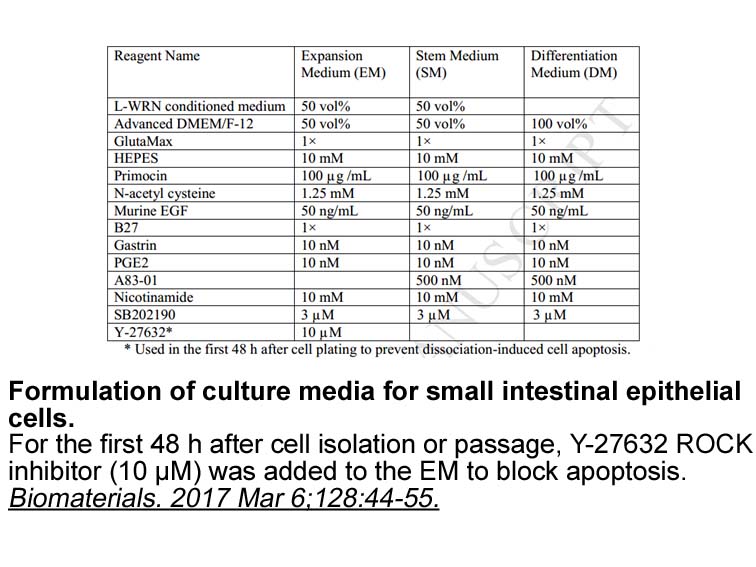Archives
It is interesting that Li et al reported that
It is interesting that Li et al. (2008) reported that AChR-immunized FcγRIIB knock out (KO) mice are significantly resistant to antibody-mediated EAMG. This is in contrast with previous studies, but does not contradict the results presented here. Despite their observation that the incidence and severity of EAMG in FcγRIIB KO mice was less than that of wild type (WT) mice, they also observed that AChR-immunized FcγRIIB KO mice displayed high serum anti-AChR antibody, CIC levels, and NMJ C3/IgG deposits. These results indicate that FcγRIIB can still be used as an inhibitory receptor in B cell target therapy.
In this paper, we provide a new therapeutic strategy involving cross-linking disease-associated B cell surface BCR with inhibitory FcγRIIB to selectively eliminate autoantigen reactive B cells. We successfully observed the apoptosis and elimination of AChR-reactive B cells in both in vitro and ex vivo studies in MG. Although this new idea showed beneficial effects for disease-associated B cells, there are still many limitations that need to be emphasized in our study. We only examined the cytotoxicity of AChR-Fc fusion protein in vitro, so whether the fusion protein can eliminate AChR-reactive B cells in MG animal models will need to be further verified. Despite its limitations this study clearly indicates that an autoantigen and Fc fusion strategy can provide a new treatment option for MG and many other autoimmune diseases.
Acknowledgment
This work was supported by the National Natural Science Foundation of China (nos. 30570641 and 30870841).
Introduction
Approximately 80–90% of patients with generalized myasthenia gravis (MG) have circulating autoantibodies against the muscle cysteine protease receptor (AChR) (Lindstrom, 2000, Vincent, 2002). These AChR antibody-positive MG  (AChR-MG) patients frequently have thymic alterations, which are characterized by expanded perivascular spaces containing lymphoid infiltrates and B cell follicles with germinal centers (Willcox, 1993, Levinson and Wheatley, 1996). B lymphocytes isolated from these thymi can spontaneously produce anti-AChR antibodies in vitro (Vincent et al., 1978, Scadding et al., 1981, Fujii et al., 1984), and many of their thymic germinal centers appear to be AChR-specific (Sims et al., 2001, Shiono et al., 2003). These findings suggest that the thymus plays pathogenetic roles in AChR-MG patients, consistently with the suspected benefits of thymectomy (Gronseth and Barohn, 2000).
In contrast, some AChR antibody-‘seronegative’ patients were reported to have autoantibodies against the muscle-specific tyrosine kinase (MuSK) (Hoch et al., 2001). The frequency of MuSK antibody-positive MG (MuSK-MG) patients varies (Scuderi et al., 2002, Evoli et al., 2003, Sanders et al., 2003), but is low in Asia (Yeh et al., 2004, Shiraishi et al., 2005). In addition, in all countries, some patients are negative for both autoantibodies: AChR/MuSK-‘seronegative’ MG (SN-MG). Two recent reports compared the pathological features of thymi from MuSK-MG, AChR-MG and SN-MG patients (Lauriola et al., 2005, Leite et al., 2005); they both emphasized that mild abnormalities were common (30–60%) in SN-MG, but were much rarer in MuSK-MG than AChR-MG.
(AChR-MG) patients frequently have thymic alterations, which are characterized by expanded perivascular spaces containing lymphoid infiltrates and B cell follicles with germinal centers (Willcox, 1993, Levinson and Wheatley, 1996). B lymphocytes isolated from these thymi can spontaneously produce anti-AChR antibodies in vitro (Vincent et al., 1978, Scadding et al., 1981, Fujii et al., 1984), and many of their thymic germinal centers appear to be AChR-specific (Sims et al., 2001, Shiono et al., 2003). These findings suggest that the thymus plays pathogenetic roles in AChR-MG patients, consistently with the suspected benefits of thymectomy (Gronseth and Barohn, 2000).
In contrast, some AChR antibody-‘seronegative’ patients were reported to have autoantibodies against the muscle-specific tyrosine kinase (MuSK) (Hoch et al., 2001). The frequency of MuSK antibody-positive MG (MuSK-MG) patients varies (Scuderi et al., 2002, Evoli et al., 2003, Sanders et al., 2003), but is low in Asia (Yeh et al., 2004, Shiraishi et al., 2005). In addition, in all countries, some patients are negative for both autoantibodies: AChR/MuSK-‘seronegative’ MG (SN-MG). Two recent reports compared the pathological features of thymi from MuSK-MG, AChR-MG and SN-MG patients (Lauriola et al., 2005, Leite et al., 2005); they both emphasized that mild abnormalities were common (30–60%) in SN-MG, but were much rarer in MuSK-MG than AChR-MG.
Methods
Results
Discussion
Our main novel finding here is the variability in SN-MG thymi and their germinal center B cells; in some patients, the B cell parameters overlap with those in AChR-MG, but, in others, with the controls. Together with the many similarities in clinical picture (Evoli et al., 2003), our results imply that some SN-MG patients might benefit from similar therapies – including thymectomy – an important possibility that demands further studies.
The frequency of MuSK positive patients among seronegative MG reported in Asian studies seem to be lower than in Caucasian patients (Yeh et al., 2004, Shiraishi et al., 2005). Yeh et al. found autoantibodies to MuSK in only 1 of 26 patients in Taiwan who lacked anti-AChR. There appear to be racial differences in the subgroups of MG (rarity of childhood MG in western countries) as well as clinical aspects. Therefore, diploid was not surprising that no MuSK positive patients were found in our small AChR seronegative series.
that some SN-MG patients might benefit from similar therapies – including thymectomy – an important possibility that demands further studies.
The frequency of MuSK positive patients among seronegative MG reported in Asian studies seem to be lower than in Caucasian patients (Yeh et al., 2004, Shiraishi et al., 2005). Yeh et al. found autoantibodies to MuSK in only 1 of 26 patients in Taiwan who lacked anti-AChR. There appear to be racial differences in the subgroups of MG (rarity of childhood MG in western countries) as well as clinical aspects. Therefore, diploid was not surprising that no MuSK positive patients were found in our small AChR seronegative series.